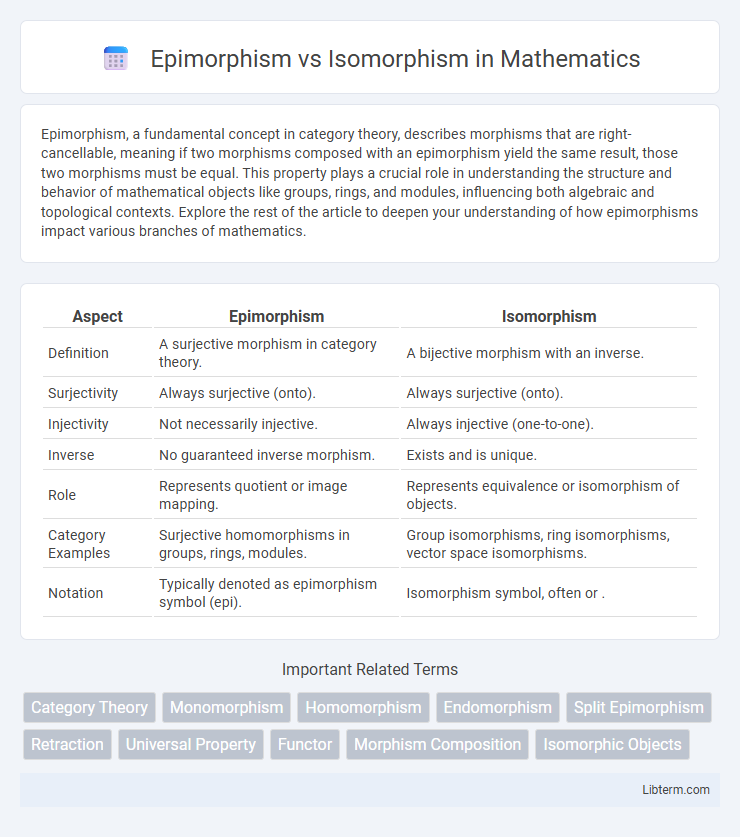Epimorphism, a fundamental concept in category theory, describes morphisms that are right-cancellable, meaning if two morphisms composed with an epimorphism yield the same result, those two morphisms must be equal. This property plays a crucial role in understanding the structure and behavior of mathematical objects like groups, rings, and modules, influencing both algebraic and topological contexts. Explore the rest of the article to deepen your understanding of how epimorphisms impact various branches of mathematics.
Table of Comparison
| Aspect | Epimorphism | Isomorphism |
|---|---|---|
| Definition | A surjective morphism in category theory. | A bijective morphism with an inverse. |
| Surjectivity | Always surjective (onto). | Always surjective (onto). |
| Injectivity | Not necessarily injective. | Always injective (one-to-one). |
| Inverse | No guaranteed inverse morphism. | Exists and is unique. |
| Role | Represents quotient or image mapping. | Represents equivalence or isomorphism of objects. |
| Category Examples | Surjective homomorphisms in groups, rings, modules. | Group isomorphisms, ring isomorphisms, vector space isomorphisms. |
| Notation | Typically denoted as epimorphism symbol (epi). | Isomorphism symbol, often or . |
Introduction to Epimorphism and Isomorphism
Epimorphisms and isomorphisms are fundamental concepts in category theory and algebra, representing different types of morphisms with specific properties. An epimorphism is a morphism that is surjective or right-cancellable, ensuring that distinct morphisms composed after it remain distinct. An isomorphism is a bijective morphism that has an inverse, guaranteeing a perfect structural equivalence between objects in a category.
Defining Epimorphism in Category Theory
Epimorphism in category theory is a morphism f: X - Y that is right-cancellative, meaning for any two morphisms g, h: Y - Z, if g f = h f then g = h. Epimorphisms generalize the concept of surjective functions in set theory but do not require f to be surjective in every category. Unlike isomorphisms, which have inverses and establish equivalences between objects, epimorphisms only ensure that morphisms from the codomain are uniquely determined by their compositions with the epimorphism.
Understanding Isomorphism: A Deeper Insight
Isomorphism in mathematics signifies a bijective homomorphism that preserves structure between two algebraic objects, ensuring an exact correspondence of elements and operations. Unlike epimorphisms, which are surjective but not necessarily injective, isomorphisms guarantee both one-to-one and onto mappings, indicating that the two structures are fundamentally identical. Understanding isomorphism provides a deeper insight into symmetry and equivalence in fields such as group theory, ring theory, and category theory, enabling the classification of objects up to structural identity.
Key Differences Between Epimorphism and Isomorphism
Epimorphism is a surjective homomorphism that maps one algebraic structure onto another, ensuring every element in the codomain has a preimage, while isomorphism is a bijective homomorphism that establishes a one-to-one correspondence between structures, implying structural equivalence. Epimorphisms preserve operations and allow for quotient structures, but do not guarantee invertibility, whereas isomorphisms are invertible mappings that preserve both structure and operation fully. The key difference lies in the bijection property; isomorphisms are both injective and surjective, making them reversible, whereas epimorphisms need only be surjective, lacking guaranteed injectivity or reversibility.
Examples of Epimorphisms in Mathematics
Epimorphisms in mathematics often appear as surjective homomorphisms, such as the canonical projection from the group of integers \(\mathbb{Z}\) onto the cyclic group \(\mathbb{Z}/n\mathbb{Z}\), which maps each integer to its equivalence class modulo \(n\). Another example is the ring homomorphism from a polynomial ring \(R[x]\) onto the quotient ring \(R[x]/(f(x))\), where \(f(x)\) is a polynomial, representing an epimorphism in ring theory. These epimorphisms differ from isomorphisms, which require bijectivity, highlighting how epimorphisms preserve structure while not necessarily being invertible.
Examples of Isomorphisms in Mathematics
Isomorphisms in mathematics are bijective homomorphisms that preserve structure, exemplified by the group isomorphism between the integers under addition and the even integers under addition, demonstrating a perfect structural match. Another example occurs in vector spaces, where any two finite-dimensional vector spaces of the same dimension over a field are isomorphic, ensuring an invertible linear map between them. These isomorphisms confirm that the algebraic objects involved are essentially the same in terms of structure, despite possible differences in their elements or representations.
Role of Epimorphism in Various Categories
Epimorphisms serve as surjective morphisms that capture the notion of "onto" mappings in category theory, playing a crucial role in defining quotient structures across algebraic categories such as groups, rings, and modules. In contrast to isomorphisms, which represent bijective morphisms and equivalences between objects, epimorphisms facilitate the construction of canonical factorization systems and characterize essential image subcategories. The role of epimorphisms extends to categorical limits and colimits, enabling the analysis of morphism compositions and the behavior of functors preserving surjectivity properties in diverse mathematical contexts.
Properties and Characterizations of Isomorphisms
Isomorphisms are morphisms in category theory that are both monomorphisms and epimorphisms, ensuring bijective structure-preserving mappings between objects. Key properties of isomorphisms include having inverses, preserving composition, and maintaining object structure exactly, which differentiates them from epimorphisms that are merely surjective but not necessarily invertible. Characterizations of isomorphisms often involve demonstrating their invertibility or bijection, confirming that objects connected by isomorphisms are structurally identical within the category.
Practical Applications: When to Use Epimorphism or Isomorphism
Epimorphisms are crucial when modeling data transformations that ensure surjective mappings, such as database schema migrations where every target element must be covered. Isomorphisms are ideal for reversible processes requiring bijective correspondences, like encoding and decoding algorithms or data serialization and deserialization. Choosing epimorphism supports data reduction and abstraction, while isomorphism guarantees structural equivalence and full retrievability in practical applications.
Summary and Conclusion: Epimorphism vs Isomorphism
Epimorphisms represent surjective homomorphisms that preserve structure while mapping onto entire target objects, whereas isomorphisms are bijective homomorphisms establishing a perfect structural equivalence between objects. The key distinction lies in epimorphisms ensuring onto mappings without necessarily being invertible, while isomorphisms guarantee both invertibility and full structural symmetry. Understanding these differences is crucial in abstract algebra and category theory for characterizing how mathematical structures relate and transform.
Epimorphism Infographic

 libterm.com
libterm.com